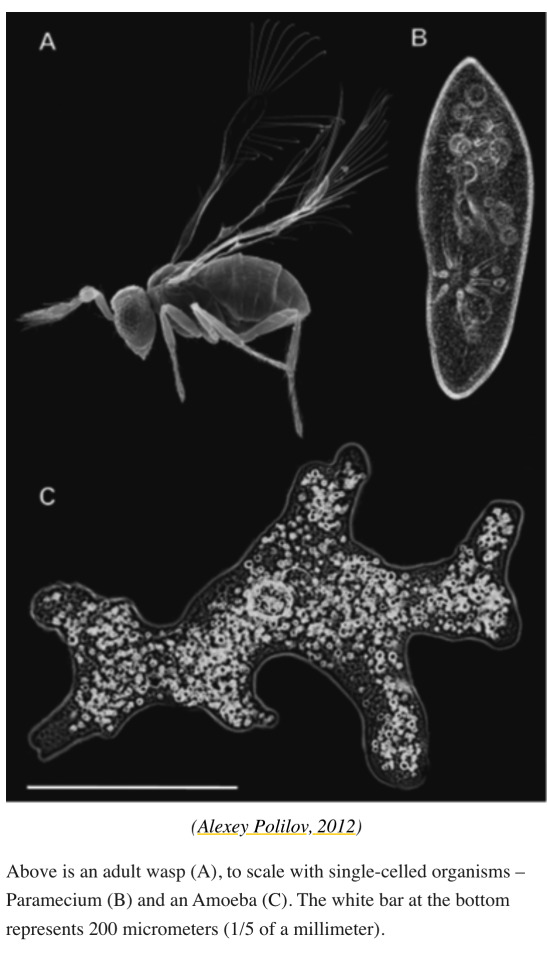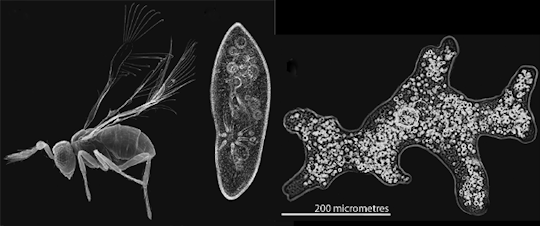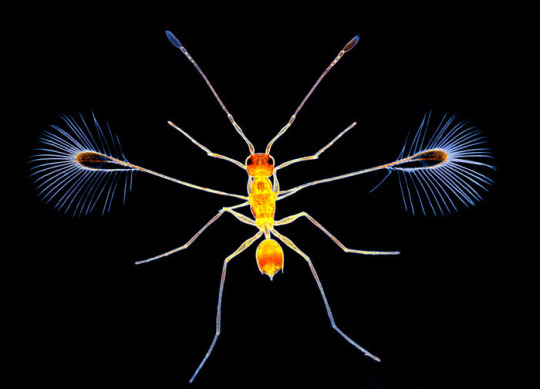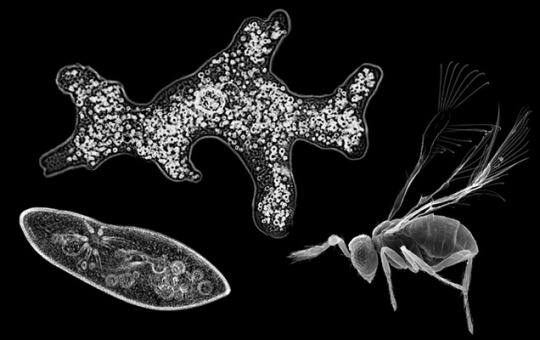#Megaphragma mymaripenne
Text
Wasps so tiny you will question everything.
Imagine being so teeny tiny that you are an endoparasite on *leafhoppers* Leafhoppers are already in the "so small they go unnoticed" category, and you're just a little pest on a minuscule thing.
Of course the group that's most likely to choose this life? The wasps Wasps are some of the smallest insects. There are "fairy flies" that are parasites of the eggs of certain insects.
They are so small that air is "thick" to them and their wings have feathered edges are are oar shaped.
Some fairly flies are so tiny that their neurons are cells without nuclei. They got rid of them to save space. They can still think though... presumably the tiniest little thoughts.
Photo by Alexey Polilov, 2012

They lay their eggs inside of the eggs of 1-2mm long crop pests.
And... read the article to see what the males are like... they are even smaller somehow, but it's ... disturbing.
#tiny#too tiny#so smol#smol#hymenoptera#wasp#wasps#fairycore#fairy flies#Megaphragma mymaripenne#Megaphragma#little#bug#bugblr#cute bugs#arthropods#insects#invertebrates
6K notes
·
View notes
Text
passing the blunt to my megaphragma mymaripenne homie but the heat of the lit end just disintegrates him
125 notes
·
View notes
Text
Une guêpe aussi grosse qu’un organisme unicellulaire
See on Scoop.it - EntomoScience

Imaginez une guêpe plus petite qu’une amibe (un organisme unicellulaire). Cela semble impossible… Mais elle existe. Elle est l’une des grandes expériences de la nature dans la miniaturisation.
Guru Med, 01.12.2011
"Commençons par les thrips qui sont des insectes minuscules, généralement juste d’un millimètre de longueur. Certains font à peine la moitié de cette taille. Imaginez alors comment un œuf de thrips pourrait être petit. Maintenant, considérons qu’il y a des insectes qui pondent leurs œufs à l’intérieur d’un œuf de thrips. C’est l’un d’eux dans l’image d’entête, une guêpe parasite, la Megaphragma mymaripenne (Trichogrammatidae). Sur la photo elle est à côté d’une paramécie et d’une amibe à la même échelle. Même si ces deux créatures sont constituées d’une seule cellule, la guêpe entière avec les yeux, le cerveau, les ailes, les muscles, les viscères et les parties génitales est en fait plus petite. Avec seulement 200 micromètres, cette guêpe est le troisième plus petit insecte vivant et un miracle de miniaturisation.
La guêpe a plusieurs adaptations pour la vie à une si petite échelle. Mais la plus impressionnante de toutes vient d’être découverte par Alexey Polilov de l’université Lomonosov à Moscou, qui a passé plusieurs années à étudier les insectes les plus petits du monde.
Polilov a constaté que la M. mymaripenne a un des plus petits systèmes nerveux de tous les insectes, composé de seulement 7400 neurones. A titre de comparaison, la mouche domestique commune en a 340 000 et l’abeille 850 000. Et pourtant, avec une centaine de fois moins de neurones, la guêpe parasite peut voler, rechercher de la nourriture et trouver les bons endroits pour pondre ses œufs.
En plus de cela, Polilov a constaté que plus de 95%, des neurones des guêpes, n’ont pas de noyau. Le noyau est le centre de commandement d’une cellule, la structure qui se trouve au milieu et stock un cache précieux de l’ADN. Sans elle, les neurones ne devraient pas être en mesure de reconstituer leurs réserves vitales de protéines. Elles ne devraient pas fonctionner. Jusqu’à présent, les neurones intacts, sans noyau, n’ont jamais été décrits dans la nature.
Et pourtant, la guêpe en a des milliers. Alors qu’elle se change d’une larve en adulte, elle détruit la majorité de ses noyaux neuronaux, seulement quelques centaines sont conservés. Elles économisent ainsi de l’espace à l’intérieur de la tête encombrée de l’adulte. Mais la guêpe ne semble pas souffrir de cette perte. En tant qu’adulte, elle vit pendant environ cinq jours, ce qui est en fait beaucoup plus que certaines autres grandes guêpes. Comme Faulkes zen écrit (lien en bas de cet article) : “Il est possible que la durée de vie des adultes soit assez courte pour que le noyau puisse produire toutes les protéines dont celui-ci à besoin pour fonctionner pendant cinq jours lors du stade de la pupe. »
Comme ils deviennent plus petits, les insectes peuvent réduire, voire faire disparaître, leurs organes. Comme en réduisant la taille de leurs organes génitaux, leurs viscères et les voies respiratoires, jusqu’à perdre totalement leur cœur : à leur taille, la diffusion est suffisante pour transporter des liquides le long de leur corps, sans avoir besoin d’une pompe.
Mais le système nerveux est plus difficile à rétrécir. Il y a une limite dans la miniaturisation des neurones et beaucoup d’entre elles doivent être regroupées dans un cerveau volumineux. C’est l’une des principales choses qui empêchent les insectes de devenir encore plus petits. De nombreux insectes ont résolu ce problème en répartissant le cerveau dans la poitrine ou l’abdomen, mais les guêpes ne peuvent pas faire cela. Elles ont seulement un lien très mince entre leur tête et le reste de leur corps. Elles doivent plutôt compter sur plusieurs adaptations extrêmes, comme se dépouiller de leur neurones et se débarrasser de leurs noyaux.
À savoir : Le deuxième plus petit insecte au monde, est un proche parent de la M. mymaripenne, appelé Megaphragma caribea, légèrement plus petite, à 170 micromètres. La détentrice du record est encore une autre guêpe, Dicopomorpha echmepterygis. Les mâles, aveugles et sans ailes, ne font que 130 micromètres de longueur. Les femelles sont légèrement plus grandes que la M. caribea.
La recherche publiée sur scienceDirect : The smallest insects evolve anucleate neurons et les précieux détails de Zen Faulkes : Non-nuclear nano neurons.
0 notes
Note
Anon who asked about your bees. I'm not a bug fan but you might just change my mind. Keep talking please.
hiiii i always take a million years to answer asks sorry. i don't have anymore 3l/ll bug takes bubbling around in my brain at the moment but i can tell you about one of my absolute favorite bugs!

these little things are called thrips, you may be familiar with them as agricultural pests. at around a millimeter in length they look more like wiggly specs of dust or grains of rice than animals to the human eye. thrips in and of themselves are creatures so small that they may as well be nothing to most people, aside from on the occasion that they appear in a huge mass to torment your crop of onions. if a thrip is that small I’m sure you can imagine how tiny, absolutely minuscule a thrip egg must be.
shifting gears for a minute, did you know that parasitic wasps are the most numerous creature on earth? anyone who’s even remotely familiar with entomology will have heard the anecdote about god having “an inordinate fondness for beetles” (quoted from the reply of a naturalist when asked if anything could be surmised about god from the study of nature) due to the sheer number of beetle species on the planet (at least 350,000!).
in reality this huge variation in species is not unique to beetles as far as insects go. beetles are beautiful, eye catching, and compelling to study which makes them historically over represented in comparison to less charismatic insects. moral of the story being that it’s not that there are a lot of beetles (although they are still probably towards the top of the list here), it’s that there are a LOT OF BUGS. parasitic wasps are the exception to this, because if nature loves beetles it loves parasitic wasps SO much more.
the thing with parasites is that they need to be incredibly specialized to their host animals, it’s a constant evolutionary arms race where the host will evolve new defenses while the parasite evolves new workarounds, leaving you with a lot of unique parasites adapted for very specific things. so you have this unimaginably huge variation in insect species and an open niche for who’s going to parasitize all these little bastards... turns out the things best at parasitizing bugs are other bugs. i’ve compared it to a matryoshka doll before. you open up a bug, and there’s another smaller bug inside. for every species of insect there is probably at least one species of parasitic wasp to match it, possibly several. let that sink in for a second. every species of insect.
when you think of wasps you probably think of hornets or yellow jackets first and foremost, or at least the sort of eusocial wasps who build paper hives and live under your drainpipe, but oh my god you have no idea. you are scraping only the surface of the deep hymenopteran ocean. wasps are everywhere. nobody actually knows exactly how many parasitic wasp species there are, and that’s because they’re usually really fucking small (tarantula hawks are outliers in this department)
that’s where the thrips come in! due to the laws of nature something must exist to parasitize all those tiny thrip eggs and that something is megaphragma mymaripenne.

these wasps reproduce by laying their own eggs inside of thrip eggs, where the baby wasp has a lovely breakfast of baby thrip upon hatching. to manage this they’re about 1/5 of a millimeter big at full adult size, close to the width of a human hair. and also smaller than a single celled amoeba, which sounds made up. it’s hard to imagine a complete animal existing at this scale, with a brain, and limbs, but it does. how the hell does this work? how is this possible?
obviously m. mymaripenne has cells. amoeba are pretty big in the grand scheme of cells. but there’s a limit to how small a cell can get and m. mymaripenne is PUSHING IT. the solution here is that their neurons don’t have nuclei, freeing up quite a bit of space (50% smaller brain!). this is the only example of this phenomenon ever discovered! neurons sort of need nuclei, so how do these guys survive? the trick is that they only live 5 days, they’re born with nuclei which produce enough protein to last them their entire comically short lives, and then the nuclei pop like little balloons and that’s it. they also have some of the smallest nervous systems in nature already at only 7,400 neurons, making them ridiculously well optimized.
everything about them is crammed into the smallest possible amount of space, the bare minimum necessary. the stripped bare essentials of what a wasp can even be.
#m#asks#bugs#of course i say this like any given entomologist wouldnt probably argue with you over whether or not there are actually more parasitic wasps#than anything else. because it is all pretty theoretical#but i am the parasitic wasp guy. and i will defend their honor to my dying breath#but most of the things that could potentially rival parasitic wasps in number of species are ALSO woefully under studied!!! because nobody#likes parasites </3
33 notes
·
View notes
Text
How tiny wasps cope with being smaller than amoebas

Thrips are tiny insects, typically just a millimeter in length. Some are barely half that size. If that’s how big the adults are, imagine how small a thrips’ egg must be. Now, consider that there are insects that lay their eggs inside the egg of a thrips.
That’s one of them in the image above – the wasp, Megaphragma mymaripenne. It’s pictured next to a Paramecium and an amoeba at the same scale. Even though both these creatures are made up of a single cell, the wasp – complete with eyes, brain, wings, muscles, guts and genitals – is actually smaller. At just 200 micrometers (a fifth of a millimeter), this wasp is the third smallest insect alive* and a miracle of miniaturization.
The wasp has several adaptations for life at such a small scale. But the most impressive one of all has just been discovered by Alexey Polilov from Lomonosov Moscow State University, who has spent many years studying the world’s tiniest insects.
Read the full article here!

* The world’s second smallest insect is a close relative of M. mymaripenne called Megaphragma caribea, slightly smaller at 170 micrometers. The record holder is yet another wasp – Dicopomorpha echmepterygis. The males, blind and wingless, are just 130 micrometers long. The females are slightly bigger than M.caribea.
2K notes
·
View notes
Note
what's a cool bug to get invested in
https://en.m.wikipedia.org/wiki/Megaphragma_mymaripenne this one!!
6 notes
·
View notes
Note
If you feature a giant wasp, also consider Megaphragma mymaripenne, which is smaller than some single-called organisms and deleted the nuclei from its brain to save space.
what the fuck is wrong with mother nature
116 notes
·
View notes
Photo

Megaphragma mymaripenne wasp.
At just 200 micrometres (a fifth of a millimetre), this wasp is the third smallest insect alive, and a miracle of miniaturisation
#miniature#insect#small#Megaphragma mymaripenne#science#microscopy#wasp#tiny#insects#microscope#micro#micrographia#microphotograph#miniaturization#entomology#scientific image#ranbow#wasps#parasitical wasp#parasite#fringe#feathers#wings#amazing#minute
34 notes
·
View notes
Photo

ScienceShot: Amoeba-Sized Insect Is Missing Some Pieces
You can't shrink down to the size of an amoeba without losing parts of yourself. That's the lesson one researcher is taking away from a microscopic analysis of the fairy wasp (Megaphragma mymaripenne), which at a mere 200 micrometers in length is one of the world's smallest animals (shown compared to a paramecium and amoeba above). When the scientist compared the neurons of adult and pupae fairy wasps, he discovered that more than 95% of adult neurons lack a nucleus. The findings, reported online this month in Arthropod Structure & Development, suggest that while a complete set of neurons is needed to grow, far less are required to live. And that helps the wasp shrink so small that it can avoid most predators and invade the eggs of other insects.(sciencemag)
35 notes
·
View notes